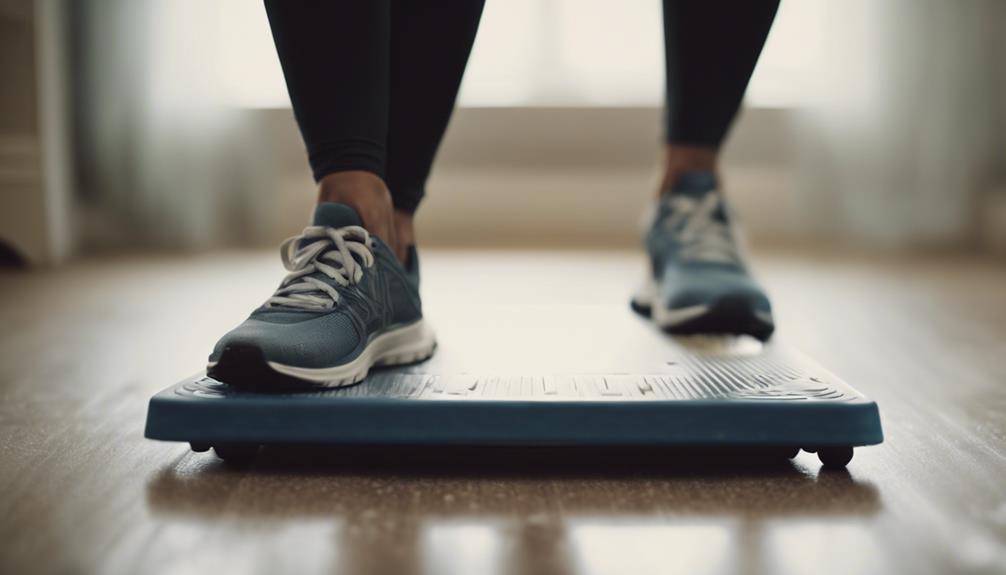Losing weight is essential for easing plantar fasciitis and heel pain, relieving strain and inflammation on the feet. Incorporating exercises like swimming and cycling, along with a balanced diet, reduces pressure on the plantar fascia. Low-impact activities promote weight loss and foot health. Strengthening exercises enhance stability and support foot health. Stretching routines improve flexibility and circulation, aiding in pain management. The Heel Challenge combines mindful movement practices and a balance of exercise and rest to optimize recovery. Transform your approach to managing discomfort and fostering foot health with these strategies.
- Understanding Plantar Fasciitis and Weight Loss
- Importance of Low-Impact Exercises
- Role of Diet in Alleviating Symptoms
- Managing Inflammation Through Exercise
- Enhancing Flexibility for Foot Health
- Weight Loss Strategies for Plantar Fasciitis
- Incorporating Mindful Movement Practices
- Balancing Exercise and Rest for Recovery
- Conclusion
Understanding Plantar Fasciitis and Weight Loss

Understanding how excess weight contributes to the discomfort of plantar fasciitis is essential in addressing heel pain effectively. When we carry extra weight, especially around the midsection, it puts added pressure on our feet, specifically the plantar fascia, the ligament that connects the heel to the front of the foot. This increased pressure can exacerbate the inflammation and micro-tears that lead to plantar fasciitis, causing intense heel pain. As a result, weight loss becomes an important component in managing this condition.
Incorporating lifestyle changes such as a balanced diet and regular exercise not only aids in shedding extra pounds but also reduces the strain on the plantar fascia. Engaging in low-impact exercises like swimming, cycling, or yoga can support weight loss efforts without adding excessive stress to the feet. Additionally, wearing proper footwear with adequate arch support and cushioning is essential for alleviating plantar fasciitis discomfort during weight loss journeys. The right shoes help distribute pressure evenly across the foot, providing stability and reducing the impact on the plantar fascia.
Importance of Low-Impact Exercises
Engaging in low-impact exercises like swimming and cycling is important for effectively managing plantar fasciitis symptoms and reducing strain on the feet. These exercises provide a cardiovascular workout without subjecting the feet to excessive pressure, making them essential for individuals looking to improve foot health. Incorporating stretching exercises within these routines is fundamental as it enhances calf muscle flexibility, which plays a significant role in alleviating plantar fasciitis discomfort.
By focusing on low-impact activities, such as swimming and cycling, individuals can work towards weight loss goals while safeguarding against further heel pain.
Avoiding high-impact activities like running or jumping is key to preventing additional damage to the plantar fascia, allowing for better recovery. Strength training also indirectly benefits plantar fasciitis by promoting lower body stability, which aids in overall foot health.
Role of Diet in Alleviating Symptoms

Maintaining a diet rich in anti-inflammatory foods plays an essential role in alleviating symptoms associated with plantar fasciitis. By making strategic diet changes, individuals can aid in reducing inflammation and managing heel pain. Including a variety of fruits, vegetables, and lean proteins in your meals can help decrease the inflammation that exacerbates plantar fasciitis. Hydration is key to promoting healing and maintaining healthy foot tissues, so make sure to drink an adequate amount of water daily.
To further support symptom relief, limit the consumption of processed foods, sugars, and unhealthy fats. These dietary adjustments not only help control weight but also reduce strain on the plantar fascia. Incorporating omega-3 fatty acids from sources like fish or flaxseed can contribute to decreasing inflammation and supporting overall foot health. Monitoring calorie intake and portion sizes while focusing on nutrient-dense foods can aid in weight loss efforts, potentially alleviating pressure on the heels.
Innovatively adapting your diet to include these elements can have a positive impact on managing plantar fasciitis symptoms. By prioritizing anti-inflammatory foods, hydration, and nutrient-dense choices, you can actively contribute to alleviating discomfort and supporting your foot health.
Managing Inflammation Through Exercise
Exercise plays a crucial role in managing inflammation associated with Plantar Fasciitis by promoting blood flow and reducing stiffness in the affected area. Low-impact activities such as swimming, cycling, and yoga offer excellent ways to improve flexibility and strengthen calf muscles without worsening heel pain. These exercises not only help in managing inflammation but also aid in weight loss efforts, which can alleviate Plantar Fasciitis symptoms over time.
Incorporating stretching exercises specifically targeted at the calf muscles can alleviate tension, prevent further damage to the plantar fascia, and support the recovery process. Additionally, including daily foot and heel exercises in your workout routine can provide added benefits in managing both inflammation and weight, thereby contributing to overall foot health.
Consistent engagement in physical activity is essential for enhancing foot health and reducing inflammation, ultimately leading to long-term relief from Plantar Fasciitis discomfort. By staying active and focusing on low-impact exercises, individuals can effectively manage their symptoms and promote healing without putting excessive strain on the affected area. Remember, every step taken towards incorporating these exercises is a step closer to alleviating heel pain and improving overall quality of life.
Enhancing Flexibility for Foot Health

To improve foot health and alleviate heel pain, focusing on enhancing flexibility through targeted exercises can be highly beneficial. Incorporating flexibility exercises into your routine can reduce tension in the calf muscles, which in turn, improves overall foot health. Stretching the calf muscles is particularly important as it can help prevent and manage symptoms of plantar fasciitis and heel pain. By enhancing flexibility in the feet, you can alleviate strain on the plantar fascia, reducing discomfort during daily activities. Regular stretching routines not only promote better circulation and flexibility in the foot but also aid in the management of plantar fasciitis.
These exercises aren’t only beneficial for foot health but can also support weight loss efforts. By incorporating foot flexibility exercises into your daily workouts, you can simultaneously work towards alleviating plantar fasciitis symptoms. The key is consistency and dedication to these stretching routines. Not only will you notice improvements in foot health and flexibility, but you may also experience reduced heel pain and discomfort associated with plantar fasciitis. Enhancing flexibility in your feet is a proactive approach to overall foot health and can contribute to a more active and pain-free lifestyle.
Weight Loss Strategies for Plantar Fasciitis
I’ll touch on some important strategies for weight loss management when dealing with Plantar Fasciitis.
Making changes to my diet and incorporating specific exercises can play a significant role in relieving the pain associated with this condition.
Dietary Changes for Relief
Strategizing dietary modifications can play a pivotal role in alleviating plantar fasciitis and heel pain by focusing on weight loss tactics. To combat inflammation and support weight loss, adopting a diet rich in fruits, vegetables, and lean proteins is vital. Hydration is key for joint health and overall weight management, aiding in the healing process of the plantar fascia. Avoiding processed foods, sugary drinks, and high-fat meals can assist in managing weight and easing Plantar Fasciitis symptoms. Monitoring calorie intake and practicing portion control are essential for weight management, reducing strain on the heels. Following a nutrient-dense meal plan ensures proper nutrition while supporting weight loss goals and the long-term management of Plantar Fasciitis.
| Dietary Changes | Benefits | Tips |
|---|---|---|
| Fruits & Vegetables | Reduce inflammation, aid in weight loss | Include in every meal |
| Lean Proteins | Support muscle health, promote weight loss | Incorporate daily |
| Hydration | Promote joint health, aid in weight loss | Drink water regularly |
Exercise for Healing
When dealing with Plantar Fasciitis and aiming for weight loss, incorporating low-impact exercises like swimming and cycling can be highly beneficial. These exercises are gentle on the feet, promoting weight loss without aggravating heel pain.
Additionally, combining stretching with cardio workouts enhances lower body flexibility, aiding in symptom management. Engaging in strength training indirectly improves Plantar Fasciitis by boosting overall stability, supporting foot health.
It’s vital to steer clear of high-impact activities like running to prevent further strain on the plantar fascia. Finding the right balance between exercise intensity and foot health is key to effective weight loss strategies for individuals suffering from Plantar Fasciitis.
Incorporating Mindful Movement Practices

Incorporating mindful movement practices such as yoga and Tai Chi can be beneficial in managing plantar fasciitis by improving flexibility and reducing tension in the calf muscles. These practices focus on body awareness, breathing techniques, and gentle movements that not only aid in relieving heel pain but also promote overall well-being. By integrating mindful movement into daily routines, individuals with plantar fasciitis can experience relaxation, reduced stress levels, and support their weight loss goals.
The emphasis on alignment, posture, and controlled movements in mindful practices can greatly benefit foot health and decrease the risk of injury. Through regular engagement in these activities, individuals can enhance their balance, coordination, and muscle strength, contributing to a healthier lifestyle and better management of plantar fasciitis symptoms.
Furthermore, mindful movement practices offer a holistic approach to healing, addressing both the physical and mental aspects of wellness. By incorporating these practices, individuals can cultivate mindfulness, reduce stress levels, and improve their overall quality of life while actively working towards alleviating heel pain and discomfort associated with plantar fasciitis.
Balancing Exercise and Rest for Recovery
Resting adequately between exercise sessions is essential for the effective recovery and healing of the plantar fascia to alleviate heel pain. Balancing exercise and rest for recovery is important in managing plantar fasciitis and heel pain. Here are key points to keep in mind:
- Mixing High and Low Impact: Integrating low-impact exercises alongside high-impact activities can help prevent further strain on the heel while promoting healing.
- Reducing Inflammation: Adequate rest periods aid in reducing inflammation within the plantar fascia, ultimately easing heel pain over time.
- Preventing Overuse Injuries: Rest days are crucial for preventing overuse injuries, allowing the body time to repair and strengthen the affected area.
- Listening to Body Signals: Paying attention to your body’s cues and adjusting exercise intensity or frequency based on pain levels is important for supporting plantar fasciitis recovery.
- Customizing Recovery: Tailoring rest periods and exercise routines to your individual needs can optimize recovery and prevent exacerbation of symptoms.
Conclusion
Losing weight to alleviate plantar fasciitis and heel pain is like shedding heavy chains off your feet, allowing you to walk with ease and lightness.
By incorporating low-impact exercises, mindful movement practices, and a balanced diet, you can open the door to a pain-free future.
Remember, every step towards weight loss is a step towards healing your heels and reclaiming your mobility.

